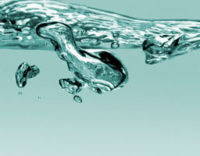Corrosion-Resistant Waterborne Polyurethane Coatings
Stand Up to the Elements

It’s tough out there, especially for metals that aren’t protected from the elements. Formulators increasingly are turning to waterborne polyurethane technology when choosing a direct-to-metal (DTM) coating for use in the construction, automotive, protective and industrial metal markets. At the top of their must-have lists are coatings that offer good adhesion to metal substrates, corrosion protection, ease of application and exterior durability characteristics.
One-component (1K) waterborne polyurethane coating technology offers these sought-after characteristics – excellent adhesion, corrosion resistance, faster application time and low odor – when compared with traditional metal coatings. Bayer MaterialScience LLC researchers wanted to prove that this promising coating technology would perform on metal substrates when used in demanding construction and industrial applications.
As a starting point, our researchers set out to assess how 1K waterborne polyurethane coatings compared with the adhesion and corrosion-resistant properties of water-based acrylic and solvent-based alkyd coatings when placed under strenuous testing using ASTM standards.
Solventborne alkyd coatings have traditionally been used for DTM coatings. These products provide some level of protection from corrosive conditions but exhibit inferior adhesion and humidity resistance.
Keeping these traditional solventborne coating limitations in mind, Bayer scientists began looking for a coating technology that combined corrosion resistance and good adhesion properties with ease of use, ease of field repair, low to zero VOCs and low energy requirements.
They developed and tested one-coat DTM 1K waterborne polyurethane formulations and compared them with commercially available waterborne acrylic and solventborne alkyd coatings. The coatings were applied to three types of steel panels and tested for adhesion, Cleveland condenser humidity resistance and salt-fog corrosion resistance.
The coatings were applied to these steel panels:
• B952 − (zinc phosphate-treated) steel;
• B1000 − (iron phosphate-treated) steel; and
• Cold-rolled steel.
Next, the coatings were tested using the following standards:
• Adhesion (ASTM Method D3359): Samples cure for one week at ambient temperature and then are tested for crosshatch adhesion.
• Cleveland condenser humidity resistance (ASTM D4585): The samples cure for one week at ambient temperature and then are placed in a cabinet that is held at 35 °C and 100% humidity for 500 h. A crosshatch adhesion test is performed and the results reported for humidity resistance.
• Salt-fog corrosion resistance (ASTM B117-97): Scored samples are placed in a salt-fog cabinet and sprayed continuously with saltwater for a duration of 500 h at 40 °C. The steel samples are removed from the cabinet and the coating is scratched along the score line to determine the extent of rusting and if there is delamination of the coating from the substrate.
The study showed that DTM 1K waterborne polyurethane formulations provided the best performance profile when compared to commercially available acrylic- or alkyd-based coatings, while offering low odor, low energy requirements, ease of application and ease of field repair.
Good Corrosion Resistance Due to Resin Chemistry or Paint Formulation?
As promising as these tests were, we wanted to determine whether the excellent performance properties of the 1K waterborne polyurethane were a result of the resin chemistry or the make-up of the paint formulations.
Researchers chose four different water-based acrylics that they expected to be useful for DTM coatings and formulated paints using the same formulation as the waterborne polyurethane in the previous testing.
Corrosion testing showed that three of the four acrylic-based coatings performed well on zinc phosphate-treated steel panels (Figure 1).

|
| Figure 1 Click here to enlarge |
Scientists were surprised to find that one coating peeled away from the steel testing panel after 500 h in salt fog while the other three fared better. The corrosion resistance for the acrylic-based coatings was worse when applied to iron phosphate steel panels. The lowest performance occurred on cold-rolled steel panels. Based on these tests, the researchers determined that the water-based acrylic coatings simply didn’t perform as well as the water-based polyurethane when formulated the same way.
From there, researchers developed formulations blending 1K waterborne polyurethane with waterborne polyacrylates. This is a common approach for commercial applications as it attempts to create a formulation blend that achieves the higher performance properties of polyurethane-based coatings but relies on the lower cost of acrylic-based coatings.
Researchers substituted the standard DTM polyurethane formulation with one that utilized polyacrylate. In this test, the following blends were applied to the same substrates and tested using the previous standards:
• 100% polyurethane;
• 75:25 polyurethane:acrylic;
• 50:50 polyurethane:acrylic;
• 25:75 polyurethane:acrylic.
To ensure consistency, the system solids and pigment-to-binder concentration remained the same in these formulations. The coatings were tested using the same process as before. As expected, all formulations showed good adhesion to steel and aluminum substrates. The formulations with higher levels of polyurethane performed better when it came to corrosion resistance. In fact, the formulation with the highest ratio of polyurethane demonstrated the highest corrosion resistance.

|
| Figure 2 Click here to enlarge |
Based on the corrosion testing, decreasing corrosion resistance performance occurs with formulations comprised of less than 50% polyurethane (Figure 2).
Conclusions
Whether used in exterior (mail boxes, lawn furniture, etc.) or interior (pipes, structural supports, etc.) applications, metals are vulnerable to the elements without the proper coating. The properties of 1K waterborne polyurethane coatings help protect metal substrates, especially for the commercial, industrial and residential markets.
Compared with existing acrylic-based coatings, 1K waterborne polyurethane coatings offer significant benefits to building owners, contractors and do-it-yourselfers, including better corrosion resistance, low VOCs, low odor, low energy requirements and ease of field repair.
The 1K waterborne polyurethane coating resin studied exhibits ease of application, excellent corrosion protection and excellent adhesion to metal substrates. In fact, stringent testing for humidity, salt fog and adhesion indicates that waterborne polyurethanes and blends of waterborne polyurethanes exhibit excellent humidity resistance, superior corrosion resistance and better adhesion than currently available waterborne polyacrylates or solventborne alkyds. n
The authors would like to acknowledge the laboratory work of Lindsey Shaffer, without which this paper would not be possible.
Looking for a reprint of this article?
From high-res PDFs to custom plaques, order your copy today!








